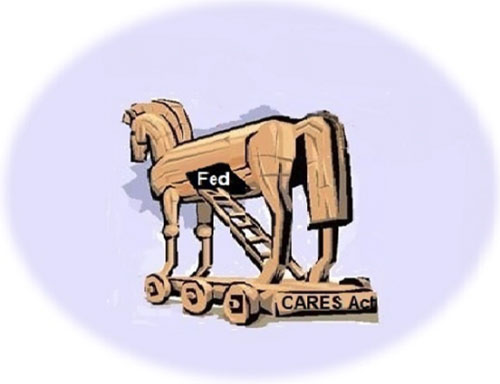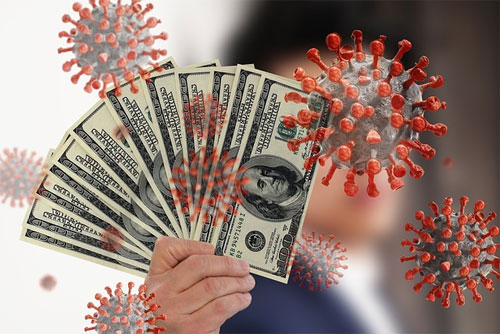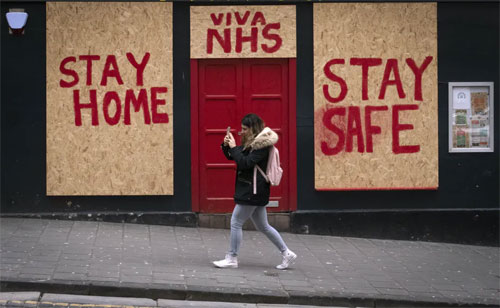Lockdowns, coronavirus, and banks: following the money (1)
It usually makes sense to follow the money when seeking understanding of almost any major change. The strategy of following the money in our current convergence of crises in late summer of 2020 leads us directly to the lockdowns. The lockdowns were first imposed on people in the Wuhan area of China. Then other populations throughout the world were told to “shelter in place,” all in the name of combating the Covid-19 virus.

Understanding of the enormous impact of the lockdowns is still developing. The lockdowns are proving to pack a far more devastating punch than any other aspect of the strange sequence of events that is making 2020 a year like no other. Even when the issues are narrowed to those of human health, the lockdowns have had, and will continue to have, far more wide-ranging and devastating impacts than the celebrity virus.
The lockdowns have, for starters, been directly responsible for explosive rates of suicide, domestic violence, overdoses, and depression. In the long run, these maladies from the lockdowns will probably kill and harm many more people than COVID-19.
But this comparison does not tell the full story. The nature and length of the lockdowns are causing millions of people to lose their jobs, businesses and financial viability. It seems that the economic descent is still gathering force. The assault of the lockdowns on our economic wellbeing still has much farther to go.
The lockdowns have proven to be a powerful instrument of social control. This attribute is becoming very attractive especially to some politicians. They have discovered they can derive considerable political traction from hyping and exploiting the largely manufactured pandemic panic.
The lockdowns are still a work-in-progress. There are past lockdowns, revolving lockdowns, partial lockdowns, mandatory lockdowns, voluntary lockdowns, severe lockdowns and probably an array of many lockdown types yet to be invented.
The lockdowns extend to disruptions in supply chains, disruptions in money flows, drops in consumption, breakdowns in transport and travelling, increased bankruptcies, losses of finance leading to losses of housing, as well as the inability to pay taxes and debts.
The lockdowns extend beyond personal habitations to prohibitions on large assemblies of people in stadiums, concert halls, churches, and a myriad of places devoted to public recreation and entertainment. On the basis of this way of looking at what is happening, it becomes clear the economic and health effects of the lockdowns are far more pronounced than the damage wrought directly by the new coronavirus.
This approach to following the money leads to the question of whether the spread of Covid-19 was set in motion as a pretext. Was Covid-19 unleashed as an expedient for bringing about the lockdowns with the goal of crashing the existing economy? What rationale could there possibly be for purposely crashing the existing economy?
One possible reason might have been to put in place new structures to create the framework for a new set of economic relationships. With these changes would come accompanying sets of altered social and political relationships.
Among the economic changes being sought are the robotization of almost everything, cashless financial interactions, and elaborate AI (Artificial Intelligence) impositions. These AI impositions extend to digital alterations of human consciousness and behavior. The emphasis being placed on vaccines is very much interwoven with plans to extend AI into an altered matrix of human nanobiotechnology.
There are other possibilities to consider. One is that in the autumn of 2019 the economy was already starting to falter. Fortuitously for some, the new virus came along at a moment when it could be exploited as a scapegoat. By placing responsibility for the economic debacle on pathogens rather than people, Wall Street bankers and federal authorities are let off the hook. They can escape any accounting for an economic calamity that they had a hand in helping to instigate.
A presentation in August of 2019 by the Wall Street leviathan, BlackRock Financial Management, provides a telling indicator of foreknowledge. It was well understood by many insiders in 2019 that a sharp economic downturn was imminent. At a meeting of central bankers in Jackson Hole Wyoming, BlackRock representatives delivered a strategy for dealing with the future downturn. Several months later during the spring of 2020 this strategy was adopted by both the US Treasury and the US Federal Reserve. BlackRock’s plan from August of 2019 set the basis of the federal response to the much-anticipated economic meltdown.
Much of this essay is devoted to considering the background of the controversial agencies now responding to the economic devastation created by the lockdowns. One of these agencies is empowered to bring into existence large quantities of debt-laden money. The very public role in 2020 of the Federal Reserve of the United States resuscitates many old grievances. When the Federal Reserve was first created in 1913 it was heavily criticized as a giveaway of federal authority. The critics lamented the giveaway to private bankers whose firms acquired ownership of all twelve of the regional banks that together constitute the Federal Reserve. Of these twelve regional banks, the Federal Reserve Bank of New York is by far the largest and most dominant especially right now.

The Federal Reserve of the United States combined forces with dozens of other privately-owned central banks throughout the world to form the Bank of International Settlements. Many of the key archetypes for this type of banking were developed in Europe and the City of London where the Rothschild banking family had a large and resilient role, one that persists until this day.
Along with the Federal Reserve Bank of New York, BlackRock was deeply involved in helping to administer the bailout in 2008. This bailout resuscitated many failing Wall Street firms together with their counterparties in a number of speculative ventures involving various forms of derivatives. The bailouts resulted in payments of $29 trillion, much of it going to restore failing financial institutions whose excesses actually caused the giant economic crash. Where the financial sector profited greatly from the bailouts, taxpayers were abused yet again. The burden of an expanded national debt fell ultimately on taxpayers who must pay the interest on the loans for the federal bailout of the “too big to fail” financial institutions.
Unsettling precedents are set by the Wall Street club’s manipulation of the economic crash of 2007-2010 to enrich its own members so extravagantly. This prior experience bodes poorly for the intervention by the same players in this current round of responses to the economic crisis of 2020.
In preparing this essay there were reviewed many articles by Pam Martens and Russ Martens in Wall Street on Parade. These hundreds of well-researched articles form a significant primary source on the recent history of the Federal Reserve, including over the last few months.
In this essay it is drawn a contrast between the privately-owned regional banks of the Federal Reserve and the government-owned Bank of Canada that once issued low-interest loans to build infrastructure projects. With this arrangement in place, Canada went through a major period of national growth between 1938 and 1974. Canada emerged from this period with a national debt of only $20 billion. Then in 1974 Prime Minister Pierre Trudeau dropped this arrangement to enable Canada to join the Bank of International Settlements. One result is that national debt rose to $700 billion by 2020.
We need to face the current financial crisis by developing new institutions that avoid the pitfalls of old remedies for old problems that no longer prevail. We need to make special efforts to change our approach to the problem of excessive debts and the overconcentration of wealth in fewer and fewer hands.
Locking down the viability of commerce
Of all the facets of the ongoing fiasco generally associated with the coronavirus crisis, none has been so widely catastrophic as the so-called “lockdowns.” The supposed cure of the lockdowns is itself proving to be much more lethal and debilitating than Covid-19’s flu-like impact on human health.
Many questions arise from the immense economic consequences attributed to the initial effort to “flatten the curve” of the hospital treatments for Covid-19. Did the financial crisis occur as a result of the spread of the new coronavirus crisis? Or was the Covid-19 crisis set in motion to help give cover to a long-building economic meltdown that was already well underway in the autumn of 2019?
The lockdowns were first instituted in Wuhan China with the objective of slowing down the spread of the virus so that hospitals would not be overwhelmed. Were the Chinese lockdowns engineered in part to create a model to be followed in Europe, North America, Indochina and other sites of infection like India and Australia? The Chinese lockdowns in Hubei province and then in other parts of China apparently set an example influencing the decision of governments in many jurisdictions. Was this Chinese example for the rest of the world created by design to influence the nature of international responses?
The lockdowns represented a new form of response to a public health crisis. Quarantines have long been used as a means of safeguarding the public from the spread of contagious maladies. Quarantines, however, involve isolating the sick to protect the well. On the other hand the lockdowns are directed at limiting the movement and circulation of almost everyone whether or not they show symptoms of any infections.
Hence lockdowns, or, more euphemistically “sheltering in place,” led to the cancellation of many activities and to the shutdown of institutions. The results extended, for instance, to the closure of schools, sports events, theatrical presentations and business operations. In this way the lockdowns also led to the crippling of many forms of economic interaction. National economies as well as international trade and commerce were severely impacted.

The concept of lockdowns was not universally embraced and applied. For instance, the governments of Sweden and South Korea did not accept the emerging orthodoxy about enforcing compliance with all kinds of restrictions on human interactions. Alternatively, the government of Israel was an early and strident enforcer of very severe lockdown policies.
At first it seemed the lockdown succeeded magnificently in saving Israeli lives. According to Israel Shamir, in other European states the Israeli model was often brought up as an example. In due course, however, the full extent of the assault on the viability of the Israeli economy began to come into focus. Then popular resistance was aroused to reject government attempts to enforce a second wave of lockdowns against a second wave of supposed infections. As Shamir sees it, the result is that “Today Israel is a failed state with a ruined economy and unhappy citizens.”
In many countries the lockdowns began with a few crucial decisions made at the highest level of government. Large and proliferating consequences would flow from the initial determination of what activities, businesses, organizations, institutions and workers were to be designated as “essential.”
The consequences would be severe for those individuals and businesses excluded from the designation identifying what is essential. This deep intervention into the realm of free choice in market relations set a major precedent for much more intervention of a similar nature to come.
The arbitrary division of activities into essential and nonessential categories created a template to be frequently replicated and revised in the name of serving public heath. Suddenly central planning took a great leap forward. The momentum from a generation of neoliberalism was checked even as the antagonistic polarities between rich and poor continued to grow.
To be defined as “nonessential” would soon be equated with job losses and business failures across many fields of enterprise as the first wave of lockdowns outside China unfolded. Indeed, it becomes clearer every day that revolving lockdowns, restrictions and social distancing are being managed in order to help give false justification to a speciously idealized vaccine fix as the only conclusive solution to a manufactured problem.
What must it have meant for breadwinners who fed themselves and their families through wages or self-employment to be declared by government to be “non-essential”? Surely for real providers their jobs, their businesses and their earnings were essential for themselves and their dependents. All jobs and all businesses that people depend on for livelihoods, sustenance and survival are essential in their own way.
Read the second part of the article
yogaesoteric
October 28, 2020
